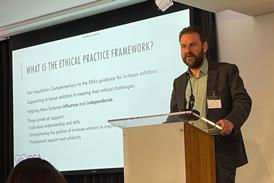In two recent welfare cases I acted in, standard timetabling quietly ignored something the court cannot return: time with family. In one, a daughter’s contact with her elderly mother (P) was curtailed due to assertions the care home could not later substantiate; the manager who drove those concerns then ‘parted ways’ with the home. By the time disclosure was unpicked and restrictions eased, P had died.

In another, a husband saw the first hearing vacated and met the familiar cascade: six weeks for a local authority statement, two for his reply, two for his wife’s (who was P) solicitor, then additional weeks to a directions hearing at which no decision was likely. He asked me whether paying more could make it urgent.
Those of us who work in the Court of Protection understand why things take time. The investigatory model aims for sound, proportionate best-interests decisions. Practitioners may run 20-30 different matters; while one case waits, another requires urgent attention. For families with one case – their mother or their husband – life is lived in the gaps between directions. The harm is not only anxiety or cost. It is lost weeks of contact, routines slipping away, birthdays not shared. There is no process by which their loss could be subsequently compensated.
The first case shows how a case can begin with thin assertions and become self-justifying. Serious-sounding concerns prompted restrictions. Disclosure was slow and piecemeal. The provider could/would not produce contemporaneous records that would have allowed a swift, proportionate interim approach. Each adjournment made sense in isolation – actual progress was always just around the corner. It was not bad faith or incompetence; it was the gravity of the issues colliding with a stretched system. The practical effect was that a daughter was kept at arm’s length until there was no time left to repair the distance.
The second case shows a different problem. Even when everyone behaves properly, the standard timetable can itself be the harm. Without an immediate safety concern, the court will not urgently list a matter. However, for non-professionals a six-week listing is not a peaceful interval – it is six weeks of traumatic separation sanctioned by law.
There is a legally sound answer – and it is not new. In Local Authority X v MM & Anor [2007] EWHC 2689 (Fam), Munby J criticised a restrictive plan that ‘failed to strike the balance proportionately, fairly and, dare I say so, even humanely between the proper need to minimise the risks to MM’s physical and mental health and safety and the equally pressing need to further her emotional welfare – her happiness’. The same judgment emphasised ‘sensible risk appraisal’ – not avoiding all risk at any price, but tolerating manageable risks where that is the price of achieving the person’s happiness.
What follows in practice? First, time must be considered as a substantive factor. We work within necessity and least-restrictive principles. Let us add a ‘time-loss’ lens when considering contact disputes. Where immediate risk is weakly particularised and harm is speculative, the interim position should lean towards maintaining family life, with clear, concrete reasons required for departure. This is MM’s sensible risk appraisal applied to the human costs of delay.
Second, tighten what is asked for and when. Timetables should drive towards a decision hearing, not additional directions. If parties seek sequential statements, they should explain why simultaneity would be unfair or unhelpful. If a provider relies on records, those records – not extracts – should be produced early. ‘Particularised risk’ should mean particulars: dates, triggers, behaviours, consequences – not generic mumblings of potential harm. If disclosure must be phased, interim contact should reflect that uncertainty rather than mirror the most restrictive scenario.
Third, make roundtable meetings work. Ask the questions that matter: what can safely be decided now? What interim arrangements best preserve family life pending the next step? What will be different by the next hearing, and is there a realistic prospect of finality? Focus on determination, not drift.
Fourth, explain process better. Lawyers normalise timetables because we see them constantly. Clients hear ‘six weeks’ and their hearts sink. We can validate that reaction while being candid about constraints. Advise explicitly that time is a live issue we will place before the court. Quantify the time cost in position statements: what contact will be lost if we list in 10 weeks rather than four; what relationships risk disintegration; what we know – and do not – about the harm used to justify restrictions.
Finally, a cultural point. The Court of Protection’s strength is humane decision-making based on evidence. Unfortunately, seeking completeness may delay a fair interim decision. Where the harm of waiting impacts the very thing in dispute – family life – the system should prefer earlier, proportionate decisions that can be revisited if new evidence changes the picture. That may require firmer listing practices (vacating only on compelling grounds), sharper expectations for disclosure, and a readiness to reach an interim decision on the present evidence.
Resources are tight. That is precisely why we must be honest about the human cost of ‘ordinary’ delay. The daughter in my first case was right when she said she was losing time. In the end, time was what the system could not give back. If we place that principle – alongside MM’s sensible risk appraisal – at the centre of case management, then even when proceedings cannot be made fast, they can at least be made kinder.
Hanna Whitehead is an associate at Ramsdens Solicitors, Halifax































No comments yet